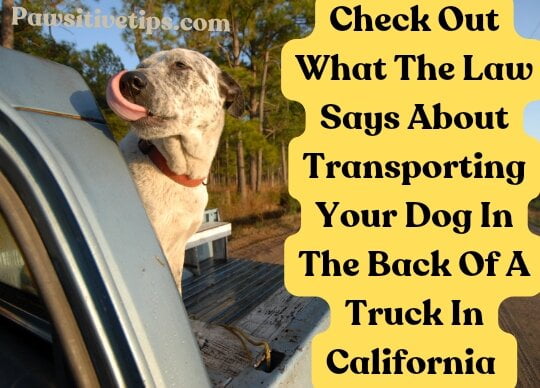Understanding the Dog in Back of Truck Law: What You Need to Know in California

Remember when we wrote about what the law says about riding with your dog in the back of your truck in Virginia? Well, if you’ve not seen that article, kindly check it out. Now, let’s check out what you also need to know while riding with a dog in the back of a truck in California. What does California’s animal law say about this? Is it a crime to travel with your dog in the back of your truck in California? All this and much more will be reviewed in this article.
The Dog in Back of Truck Law in California is officially known as California Vehicle Code Section 23117. It aims to ensure the safety and well-being of dogs while being transported in vehicles. This law sets specific guidelines and requirements for transporting dogs in the back of trucks. If you are a dog owner or frequently travel with dogs in your truck, it’s very important to understand this law to ensure the safety of your furry friend. In this article, we will delve into the details of the Dog in Back of Truck Law in California, including its requirements, penalties for violations, safety concerns, helpful tips for responsible dog transportation, etc.
Is It OK to Put a Dog in the Back of a Truck in California?
No, it is generally not okay to put a dog in the back of a truck while traveling on the road. According to California law, code section 23117, no person driving a truck or motor vehicle is allowed to transport any dog or animal in the back of the truck or vehicle in a space intended for any load on the highway unless certain conditions are met.
Firstly, the space in the back of the truck or vehicle must be enclosed or have side and tail racks that extend vertically to a minimum height of 46 inches from the floor. This ensures that the animal is contained within the designated area and prevents them from jumping or falling out of the truck or vehicle.
Alternatively, the truck or vehicle must have installed means to prevent the animal from being discharged. This can include securing the animal with a cross tethering system, which restricts their movement and prevents them from exiting the vehicle.
Another acceptable method is to transport the animal in a secured container or cage. This ensures their safety by preventing them from being thrown, falling, or jumping from the truck or vehicle during transportation.
However, it’s important to note that there are exceptions to these regulations. The law does not apply to the transportation of livestock, as they have their own set of regulations.
Additionally, if the dog’s owner either owns or is employed by a ranching or farming operation and is traveling on a road in a rural area, or if they are traveling to and from a livestock auction, the regulations may not apply.
Similarly, if the transportation of a dog is for purposes associated with ranching or farming, the law may not be applicable in those circumstances.
These exceptions are designed to accommodate specific situations where the transportation of dogs or other animals in the back of trucks is necessary for agricultural or livestock-related activities.
Note: This law applies to all public roads, highways, and parking areas within the state of California.
Why Was the Law Implemented?
The primary goal behind implementing this law was to address the safety concerns associated with transporting dogs in the back of trucks. Dogs that are unrestrained in the open bed of a truck face a higher risk of injury or death in the event of sudden stops, turns, or accidents. So, by enforcing this law, the state of California aims to protect dogs and prevent accidents caused by distracted driving due to unsecured pets.
Penalties for Violating the Law
The penalties for violating the Dog in Back of Truck Law, officially known as California Vehicle Code Section 23117, are as follows:
First Infraction
- Fine: A minimum of fifty dollars ($50) up to a maximum of one hundred dollars ($100).
Second Infraction within One Year of a Prior Infraction
- Fine: A minimum of seventy-five dollars ($75) up to a maximum of two hundred dollars ($200).
Third or Subsequent Infraction within One Year of Two or More Prior Infractions
- Fine: A minimum of one hundred dollars ($100) up to a maximum of two hundred fifty dollars ($250).
It is important to note that these penalties are specific to violations of Section 23117, which pertains to the transportation of dogs or other animals in the back of a vehicle without proper restraints or enclosures. The severity of the penalty increases with repeated infractions within a year, indicating the importance of complying with the law to ensure the safety and well-being of animals during transportation.
What Are the Alternatives to Transporting Dogs in the Back of Trucks in California?
When it comes to transporting dogs or other animals in California, there are several alternatives to putting them in the back of trucks. These alternatives prioritize the safety and well-being of the dogs while still allowing them to accompany their owners on journeys. Here are some viable alternatives:
1: Transporting Inside the Cab
One of the safest alternatives is to transport the dog inside the cab of the truck, either in the front or back seat, depending on the size of the dog and the available space. This ensures that the dog is in a controlled environment and reduces the risk of accidents or injuries.
2: Using Safety Harnesses
Utilizing a safety harness designed for dogs can provide secure restraint during travel. These harnesses are attached to seat belts, ensuring that the dog is safely secured and unable to move around the vehicle freely. It is crucial to select a harness that fits the dog properly and is specifically designed for automotive use.
3: Securing Dogs in Crates or Carriers
Another effective method is to transport dogs in secure crates or carriers placed inside the truck’s cab. These crates or carriers should be appropriately sized for the dog, allowing them to stand, turn around, and lie down comfortably. They should be properly secured using seat belts or other fastening mechanisms to prevent shifting during transit.
4: Using Truck-Specific Crates or Bed Extenders
Manufacturers offer truck-specific crates or bed extenders designed to fit within the truck bed. These specialized crates provide a secure and designated space for the dog while ensuring proper ventilation and protection from the elements.
5: Using a Cross-Tethering System
A cross-tethering system involves securing the dog using a short leash or tether connected to opposite sides of the truck bed. This method restricts the dog’s movement, preventing them from jumping out of the vehicle. It is crucial to ensure that the tether is of appropriate length and securely attached to the truck bed to avoid entanglement or injury.
6: Using Dog Seat Belts and Boosters
Similar to safety harnesses, there are specific dog seat belts and boosters available on the market. These devices provide secure attachments and elevate the dog’s seating position, allowing them to see out of the window while being restrained safely.
Check out this>> 11 Amazing Funny Fuzzy Dog Car Seat Beds For Your Pets
7: Pet Trailers or Travel Carriers
For larger dogs or long-distance journeys, pet trailers or travel carriers can be utilized. These trailers are designed to attach securely to the back of a truck and provide a comfortable and protected space for the dog during transportation.
It is important to select the most suitable alternative based on the specific needs and characteristics of the dog, as well as the type of journey being undertaken. Each alternative should be carefully considered to ensure the dog’s safety, comfort, and compliance with the law.
Final Thoughts
The major purpose of this article is to help all dog owners understand what Vehicle Code Section 23117 says concerning transporting your dog or other animals in the back of a truck in California. So, we urge you to stay informed, follow the guidelines, and provide a secure and comfortable environment for your dog during journeys to create a positive and safe experience for both you and your furry friend.
You can also check out these contents:


